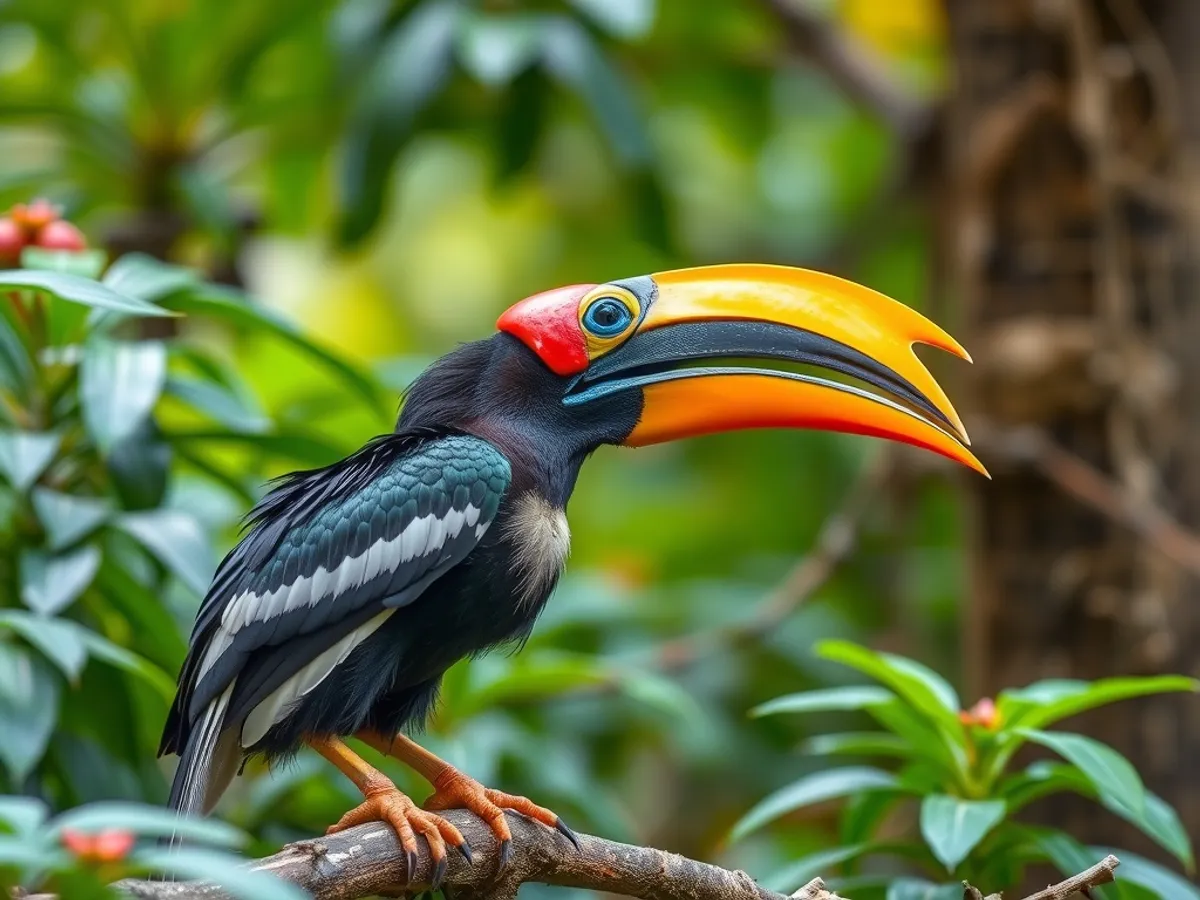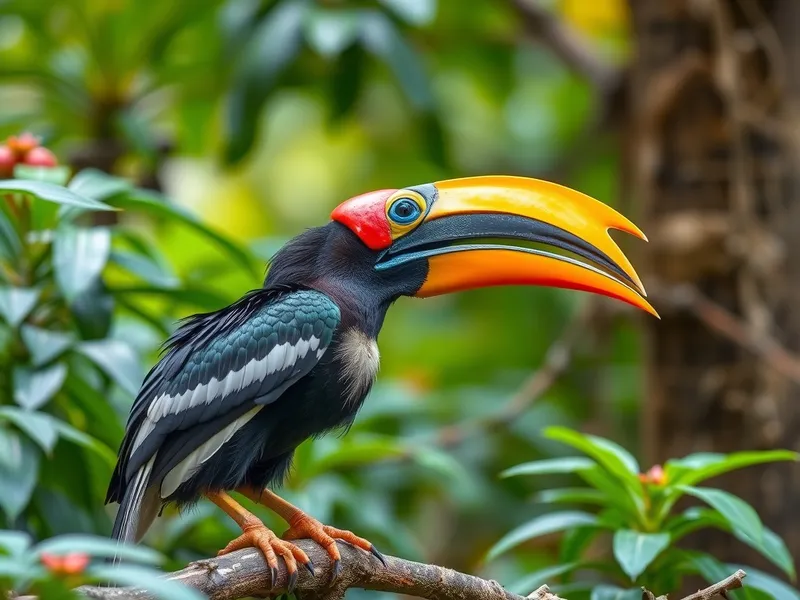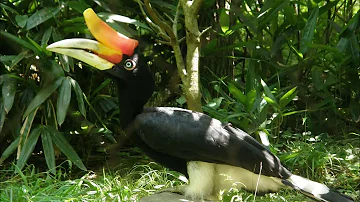
Rhinoceros Hornbill
Buceros rhinoceros

Meet the Rhinoceros Hornbill
The Rhinoceros Hornbill is a large and striking bird native to the lowland and montane forests of Southeast Asia. Distinguished by its impressive yellow-orange casque on top of its bill, this hornbill is mostly black with white legs and tail, and features a prominent red and yellow beak. It is an important cultural symbol in many Bornean tribes and is known for its loud, distinctive calls that echo through the forest canopy. The Rhinoceros Hornbill plays a crucial ecological role as a seed disperser, helping to maintain the health and diversity of tropical forests.
Classification
Bird
Habitat
Tropical and subtropical rainforest
Diet
Omnivore
Lifespan
35-40 years
Conservation
Vulnerable
Weight
2-3 kg
📖Fascinating Facts
Massive Casque
The Rhinoceros Hornbill's casque, a hollow structure atop its bill, can be as long as 30 cm and is used to amplify vocalizations.
Unique Nesting Habits
Females are sealed inside tree cavities with mud and food is passed in by the male until the chicks and female are ready to leave.
Forest Gardener
This hornbill is vital for forest ecosystems, dispersing seeds from the fruits they consume, which promotes forest regeneration.
📋Detailed Description
The Rhinoceros Hornbill (Buceros rhinoceros) is one of the largest hornbill species, with adults typically measuring 90–122 cm (35–48 in) in length and weighing between 2 and 3 kg (4.4–6.6 lbs). Its most distinctive feature is the prominent, upturned casque atop its massive bill, which is hollow and serves both as a resonating chamber for calls and a visual display during social interactions. The plumage is predominantly glossy black, with striking white on the legs and tail; the tail is marked by a broad black band. The bare skin around the eyes and throat is bright red in males and bluish in females, aiding in sexual differentiation. Rhinoceros hornbills are strong fliers, capable of covering large distances in search of fruiting trees. Their wings produce a characteristic 'whooshing' sound in flight. These birds are primarily arboreal, rarely descending to the ground, and are highly adapted to life in the upper forest canopy. Their loud, far-carrying calls are a signature sound of Southeast Asian rainforests. The species is long-lived, with lifespans exceeding 35 years in captivity, and is known for its complex breeding and nesting behaviors.
💡 Did you know?
Despite their size and powerful beaks, Rhinoceros Hornbills primarily eat fruit, but will also take small animals and insects when available.
🔬Research & Sources
Wikipedia Summary
The rhinoceros hornbill is a large species of forest hornbill (Bucerotidae). In captivity it can live for up to 35 years. It is found in lowland and montane, tropical and subtropical climates and in mountain rain forests up to 1,400 metres in Borneo, Sumatra, Java, the Malay Peninsula, Singapore, and southern Thailand.
Last Modified: 3/16/2025
🎭Behavior & Social Structure
Rhinoceros hornbills are diurnal and spend most of their day foraging in the canopy, feeding primarily on fruits such as figs (Ficus spp.), but also consuming small animals, including insects, reptiles, and occasionally small birds. They are important seed dispersers, often swallowing fruits whole and excreting seeds far from the parent tree. Socially, they are usually observed in pairs or small family groups, though larger aggregations may form at abundant food sources. Pairs maintain and defend territories through vocalizations and visual displays, with the casque playing a role in both. They are monogamous, forming long-term pair bonds. Daily routines include preening, sunning, and mutual grooming, which reinforce social bonds. Roosting occurs in tall trees, often communally outside the breeding season.
👶Reproduction & Life Cycle
Breeding typically coincides with the peak of the fruiting season, varying locally but often occurring from February to August. The species exhibits unique nesting behavior: the female seals herself inside a natural tree cavity using a mixture of mud, fruit pulp, and droppings, leaving only a narrow slit through which the male passes food. Incubation lasts about 37–46 days, during which the female is entirely dependent on the male for food. Clutch size is usually 1–2 eggs. After hatching, the female remains sealed in with the chicks for several weeks, emerging only when the chicks are partially feathered. Both parents then continue to feed the young until they fledge at around 80–90 days old. This cooperative breeding strategy provides protection from predators but makes the species highly dependent on large, old trees for nesting.
🛡️Adaptations & Survival
The Rhinoceros Hornbill has evolved several specialized adaptations. Its large casque, while hollow and lightweight, amplifies calls and serves as a visual signal in mate selection and territorial disputes. The strong, curved bill is adapted for plucking and manipulating large fruits, while the broad wings and robust tail facilitate agile maneuvering through dense forest canopies. The species’ zygodactyl feet (two toes forward, two backward) provide a strong grip on branches. Behavioral adaptations include cooperative breeding and a reliance on vocal communication to maintain pair bonds and territory boundaries in visually obstructed forest environments. The ability to digest a wide variety of fruits and animal prey allows flexibility in diet.
🎨Cultural Significance
The Rhinoceros Hornbill holds profound cultural and spiritual significance for many indigenous peoples of Borneo, including the Dayak tribes, who regard it as a symbol of the upper world and a messenger between humans and the divine. Its image is frequently depicted in traditional art, carvings, and ceremonial attire. The bird is the state emblem of Sarawak, Malaysia, and is featured in local folklore and mythology as a guardian of the forest. However, its cultural value has also contributed to hunting for ornamental purposes.
🔬Recent Research & Discoveries
Recent research has focused on the species’ role as a keystone seed disperser, highlighting its importance for forest regeneration and ecosystem health. Studies using radio telemetry and camera traps have provided new insights into home range size, habitat use, and nesting requirements. Genetic analyses have revealed low genetic diversity in some fragmented populations, raising concerns about long-term viability. Conservation programs are increasingly involving local communities in nest protection and habitat restoration. Ongoing research is examining the impacts of climate change and forest fragmentation on hornbill movement and breeding success.
🎥Wildlife Videos

Devoted hornbill couple turn nest into fortress 🌳 | Planet Earth III - BBC
If this isn't devotion, we don't know what is... While this hornbill dutifully takes care of her eggs, her devoted partner delivers all of ...
BBC

The Enchanting World of the Rhinoceros Hornbill
Discover the magic of the Rhinoceros Hornbill, a remarkable rainforest symbol of Southeast Asia. With its colorful casque and ...
The Story of Animals

20+ Hornbill Birds You Won’t Believe Nest Like This | Wildlife Documentary | BBTV Official
These Birds Seal Themselves Inside Trees to Become Mothers | Most Remarkable Hornbills on Earth Soaring above ancient ...
BBTV Official

Wreathed Hornbill - Animal Kingdom Documentary
Discover the fascinating Wreathed Hornbill in this stunning wildlife video! Perfect for bird lovers, nature enthusiasts, and anyone ...
Animal Kingdom Doc

Wild Asia: Rhinoceros Hornbill 🇹🇭 🇮🇩 🇲🇾
For my first Asian bird, here's one of Zazu's Asian cousins: the Rhinoceros Hornbill. Enjoy! @TheMovieUniverse @joyunicycle ...
Thomas Huffman (AlphalionSimba)

Rhinoceros Hornbill
Rhinoceros hornbill in the early morning hours, near Sepilok forest at MY resort. Hornbills are generally fruit eaters, figs are ...
cede prudente
🌍Habitat Information
The Rhinoceros Hornbill typically inhabits Tropical and subtropical rainforest environments. Rhinoceros Hornbills have adapted to their environments with specialized features and behaviors.
Primary Habitat:
Tropical and subtropical rainforest
More detailed habitat information will be available soon.
🛡️Conservation Status
The Rhinoceros Hornbill is currently classified as Vulnerable. Conservation efforts are crucial for preserving this species for future generations.
Common Threats:
- 🏠Habitat loss and fragmentation
- 🌡️Climate change impacts
- 🎯Hunting and poaching
- 🏭Human-wildlife conflict
⚠️Threats & Conservation Challenges
The primary threats to the Rhinoceros Hornbill are habitat loss and fragmentation due to logging, conversion of forests to agriculture (notably oil palm plantations), and infrastructure development throughout its range. The species is also at risk from hunting for its casque and feathers, which are used in traditional ornaments, as well as for the illegal pet trade. Population declines have been observed, particularly in areas with intensive deforestation. The species is listed as Vulnerable by the IUCN, with ongoing declines projected if current trends continue. Conservation challenges include the need for large, contiguous tracts of mature forest with suitable nesting trees, and effective enforcement of hunting regulations.
🔬Scientific Classification
Scientific Name
Buceros rhinoceros
Classification Hierarchy
🔍 About Taxonomic Classification
Taxonomic classification is a hierarchical system used by scientists to classify and organize living organisms based on shared characteristics and evolutionary relationships.
The system moves from broad categories (Kingdom) to increasingly specific ones, with each animal's scientific name typically consisting of its Genus and species.
📝Community Notes
Share your observations and insights about the Rhinoceros Hornbill with our community of wildlife enthusiasts.
Join Our Community
Sign in to share your observations and connect with fellow wildlife enthusiasts.
Sign In to ContributeNo community notes yet
Be the first to share your observations about the Rhinoceros Hornbill!
Explore Rhinoceros Hornbill
Select a tab above to learn more about this amazing animal.
📸Photo Gallery
No photos available for this animal yet.
🌟Discover More Wildlife
Continue your journey of discovery with more fascinating animals from our database
